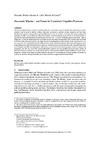Identificador persistente para citar o vincular este elemento:
https://accedacris.ulpgc.es/jspui/handle/10553/42186
| Campo DC | Valor | idioma |
|---|---|---|
| dc.contributor.author | Martín, Ricardo Muñoz | en_US |
| dc.contributor.author | De León, Celia Martín | en_US |
| dc.date.accessioned | 2018-10-19T07:25:04Z | - |
| dc.date.available | 2018-10-19T07:25:04Z | - |
| dc.date.issued | 2018 | en_US |
| dc.identifier.issn | 0904-1699 | en_US |
| dc.identifier.uri | https://accedacris.ulpgc.es/handle/10553/42186 | - |
| dc.description.abstract | The Monitor Model fosters a view of translating where two mind modes stand out and alternate when trying to render originals word-by-word by default: shallow, uneventful processing vs problem solving. Research may have been biased towards problem solving, often operationalized with a pause of, or above, 3 seconds. This project analyzed 16 translation log files by four informants from four originals. A baseline minimal pause of 200 ms was instrumental to calculate two individual thresholds for each log file: (a) A low one – 1.5 times the median pause within words – and (b) a high one – 3 times the median pause between words. Pauses were then characterized as short (between 200 ms and the lower threshold), mid, and long (above the higher threshold, chunking the recorded activities in the translation task into task segments), and assumed to respond to different causes. Weak correlations between short, mid and long pauses were found, hinting at possible different cognitive processes. Inferred processes did not fall neatly into categories depending on the length of possibly associated pauses. Mid pauses occurred more often than long pauses between sentences and paragraphs, and they also more often flanked information searches and even problem-solving instances. Chains of proximal mid pauses marked cases of potential hesitations. Task segments tended to happen within 4–8 minute cycles, nested in a possible initial phase for contextualization, followed by long periods of sustained attention. We found no evidence for problem-solving thresholds, and no trace of behavior supporting the Monitor Model. | en_US |
| dc.language | eng | en_US |
| dc.publisher | 0904-1699 | |
| dc.relation.ispartof | Hermes (Denmark) | en_US |
| dc.source | Hermes (Denmark)[ISSN 0904-1699],v. 57, p. 29-47 | en_US |
| dc.subject | 570112 Traducción | en_US |
| dc.subject.other | Baseline pause | en_US |
| dc.subject.other | Individualized thresholds | en_US |
| dc.subject.other | Cognitive processes | en_US |
| dc.subject.other | Problem solving | en_US |
| dc.subject.other | Hesitation | en_US |
| dc.subject.other | Task segments | en_US |
| dc.subject.other | Rhythm | en_US |
| dc.subject.other | Monitor Model | en_US |
| dc.title | Fascinatin’ rhythm – and pauses in translators’ cognitive processes | en_US |
| dc.type | info:eu-repo/semantics/conferenceObject | es |
| dc.type | ConferenceObject | es |
| dc.identifier.doi | 10.7146/hjlcb.v0i57.106192 | en_US |
| dc.identifier.scopus | 85052017538 | |
| dc.contributor.authorscopusid | 37095581200 | |
| dc.contributor.authorscopusid | 24437772900 | |
| dc.description.lastpage | 47 | - |
| dc.description.firstpage | 29 | - |
| dc.relation.volume | 57 | - |
| dc.investigacion | Artes y Humanidades | en_US |
| dc.type2 | Actas de congresos | en_US |
| dc.date.coverdate | Junio 2018 | |
| dc.identifier.ulpgc | Sí | es |
| dc.description.sjr | 0,102 | |
| dc.description.sjrq | Q4 | |
| dc.description.erihplus | ERIH PLUS | |
| item.grantfulltext | open | - |
| item.fulltext | Con texto completo | - |
| crisitem.author.dept | GIR IATEXT: Cognición, Lingüística, Texto y Procesamiento de la Información | - |
| crisitem.author.dept | IU de Análisis y Aplicaciones Textuales | - |
| crisitem.author.dept | Departamento de Filología Moderna, Traducción e Interpretación | - |
| crisitem.author.orcid | 0000-0001-6049-9673 | - |
| crisitem.author.orcid | 0000-0003-4548-9033 | - |
| crisitem.author.parentorg | IU de Análisis y Aplicaciones Textuales | - |
| crisitem.author.fullName | Muñoz Martín, Ricardo | - |
| crisitem.author.fullName | Martín De León, Celia | - |
| Colección: | Actas de congresos | |
Citas SCOPUSTM
14
actualizado el 08-jun-2025
Visitas
435
actualizado el 10-ago-2024
Descargas
173
actualizado el 10-ago-2024
Google ScholarTM
Verifica
Altmetric
Comparte
Exporta metadatos
Los elementos en ULPGC accedaCRIS están protegidos por derechos de autor con todos los derechos reservados, a menos que se indique lo contrario.
